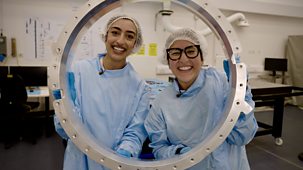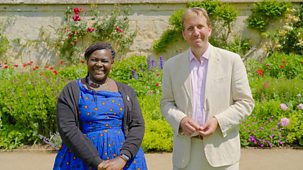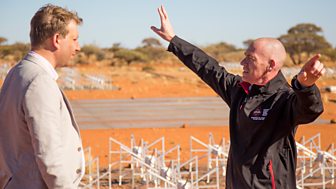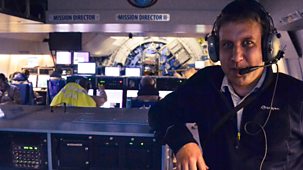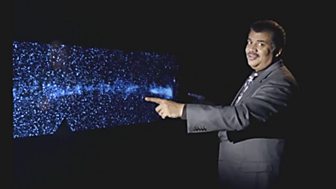
Ancestral Skies
This month, The Sky at Night teams up with BBC Ideas to discover the secrets of archaeology and astronomy and to reflect on our ancestral skies. \n\nThroughout history and across the world, humanity has looked up and marvelled at the night sky. From ancient civilizations who were guided by the sun, moon and stars, to modern astronomers uncovering the universe's history, we have always found deep meaning in our dark skies. But is modern civilisation putting this important link at risk? \n\nOut on Cornwall’s beautiful Bodmin Moor, George Dransfield meets up with archaeoastronomer Carolyn Kennett at an ancient archaeological site. The Goodaver stone circle is steeped in history, but it has been cut off from the public and researchers like Carolyn for decades. But times are changing. The site will open to the public in November, and Carolyn and fellow archaeoastronomers are finally able to assess the stones against the horizon and understand how they are aligned to the sun, moon and stars. What new stories about ancient peoples and their relationship to the night sky will be discovered? \n\nChris Lintott and Maggie Aderin-Pocock are also finding out about archaeology in Cambridge – but not necessarily the archaeology you would expect. \n\nAt the Whipple Museum of the History of Science, Maggie links up with Australian space archaeologist Dr Alice Gorman to look at what we should be preserving of our history in space so far. From satellites to moon landing sites, what will future generations want to see to help them understand our early history of our journey into space?\n\nMeanwhile, Chris heads to the Department of Archaeology to find out about the surprising and fascinating field of Galactic Archaeology, which takes inspiration from archaeology to try and solve the mystery of our galaxy’s history – using only what we can see today. Chris meets anthropologist and evolutionary biologist Professor Robert Foley and astrophysicist Dr Payel Das, who are part of a team that has been using phylogenetic trees – models normally used for evolution – for modelling the evolution of galaxies. Each generation of stars within a galaxy forms from material polluted with elements produced by previous generations, opening up the possibility of understanding their shared history. \n\nFinally, Pete Lawrence is at the Exmoor Dark Skies Festival, where he is meeting Jo Richardson. While Pete waits for night to fall, he talks to Jo about the importance of maintaining our view of the night sky and how modern lighting is affecting the health and well-being of humans and other animals. But will the clouds clear and provide the spectacular view dark skies sites can offer?\n\nDon’t miss this captivating exploration of our shared history and the stars, as we discover where archaeology and astronomy meet to illuminate the profound connections that shape our understanding of both the universe and ourselves!
Source: BBC 4
Most recent episodes of The Sky at Night
The Sky At Night
Asteroid Strike?
The team explore one of the biggest stories in space news, the ‘city killer’ asteroid 2024 YR4. First observed on 27 December 2024, it soon became one of the biggest ...
17-04-2025
BBC 4
The Sky At Night
Ancestral Skies
This month, The Sky at Night teams up with BBC Ideas to discover the secrets of archaeology and astronomy and to reflect on our ancestral skies. \n\nThroughout history and acros ...
14-11-2024
BBC 4
The Sky At Night
Question Time Special
Get ready for The Sky at Night’s annual Question Time Special, where viewers get the opportunity to ask the questions they have always wanted answered about our universe.\ ...
08-10-2024
BBC 4
The Sky At Night
2075: Our Place In Space
The Sky at Night is embarking on a journey into the future as we explore how space will revolutionise life on Earth over the next 50 years. As humanity's reach extends into the ...
11-09-2024
BBC 4
The Sky At Night
Nicky, Nasa And The Next Frontier
In this Sky at Night special, the team talk to Dr Nicola Fox, NASA’s head of science, whose life began in the UK.\n\nPresenter Chris Lintott chats to Nicky about her early ...
15-08-2024
BBC 4
The Sky At Night
Webb Telescope: The Story So Far
In July 2022, the James Webb Space Telescope released its first images. They were visually stunning, and it was clear they provided more detail of stars, galaxies and planets th ...
11-07-2024
BBC 4
The Sky At Night
Cosmic Ghosts
This month, The Sky at Night has a spooky twist. Across the universe, there are hidden objects that we can’t see, but astronomers and scientists still believe they’r ...
13-06-2024
BBC 4
The Sky At Night
Hiding In Starlight
Total solar eclipses, like the one seen last month in North America, allow us to see details of the Sun that can’t be seen at any other time. So, this month, The Sky at Ni ...
16-05-2024
BBC 4
The Sky At Night
Space Rock Return
The Sky at Night is back for a brand new series, and this month it is delving into Nasa’s OSIRIS-REx mission, which last year brought back a sample from the near-Earth ast ...
11-04-2024
BBC 4
Most popular episodes of The Sky at Night
The Sky At Night
Asteroid Strike?
The team explore one of the biggest stories in space news, the ‘city killer’ asteroid 2024 YR4. First observed on 27 December 2024, it soon became one of the biggest ...
17-04-2025
BBC 4
The Sky At Night
The Sky At Day
The British weather is often the enemy of stargazers up and down the country. A forecast of a couple of hours of cloud cover will disappoint even the most determined amateur ast ...
13-07-2022
BBC 4
The Sky At Night
Outback Astronomy
In February 2018, news broke that astronomers had seen the cosmic dawn - the moment when stars first formed, flooding the universe with light. What's remarkable is that this inc ...
12-07-2018
BBC 4
The Sky At Night
Webb Telescope: The Story So Far
In July 2022, the James Webb Space Telescope released its first images. They were visually stunning, and it was clear they provided more detail of stars, galaxies and planets th ...
11-07-2024
BBC 4
The Sky At Night
Telescope On A Plane!
Telescope on a Plane!\n\nIn this special programme, the Sky at Night takes to the air on board the largest airborne observatory in the world – a specially modified jumbo j ...
09-12-2018
BBC 4
The Sky At Night
Space Rock Return
The Sky at Night is back for a brand new series, and this month it is delving into Nasa’s OSIRIS-REx mission, which last year brought back a sample from the near-Earth ast ...
11-04-2024
BBC 4
The Sky At Night
Mars: Red And Dead?
Maggie Aderin-Pocock and Chris Lintott reveal the latest results from Nasa's Curiosity and Esa's ExoMars TGO missions that are attempting to find signs of life on Mars. Maggie v ...
12-04-2018
BBC 4
The Sky At Night
How Gravity Shapes The Universe
The team travels to the Brecon Beacons AstroCamp to see how gravity shapes the universe. Chris finds out about the newest moon in the solar system.
18-05-2014
BBC 4
The Sky At Night
Telescope Takeover
The team travel to the island of La Palma in the Canary Islands where they take control of some of the world's largest telescopes to view the most spectacular sights in the nigh ...
12-02-2017
BBC 4




